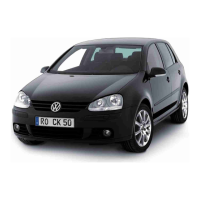This could lead to serious injuries
or deadly.
•
Have the airbag system checked immediately
by a specialist workshop.
•
Never use a child seat on the front passenger
seat. If one is fitted,
remove it! The front passenger frontal airbag
could be triggered in the event of an accident,
even in the event of an accident.
being out of order.
Description and operation
of
airbags
Problems and solutions
Please note at the beginning of this chapter on
page 45.
Failure of the airbag system or of the
belt
pre-tensioners
The yellow indicator light comes on and stays on.
In addition, a message may be shown on the
instrument panel display.
A malfunction of at least one airbag or belt
pretensioner has been detected.
—
Have your vehicle serviced by a specialist
workshop.
—
Have the airbag and seatbelt pretensioner
system checked.
Airbag system or belt pretensioner system
deactivated with a diag-
nosis
After switching on the ignition, the yellow
indicator light comes on for approx. 4 seconds
and then flashes for approx. 12 seconds. In
addition, a message may be shown in the
instrument cluster display.
At least one airbag or belt pretensioner has been
deactivated by diagnostic equipment.
—
Have your vehicle serviced by a specialist
workshop.
—
Ask to check whether the airbag or seatbelt
pretensioner system should remain deactivated.
Front passenger frontal airbag
deactivated
The yellow indicator lamp indicating that the
front passenger air bag is deactivated comes on
and stays on.
The front passenger frontal airbag has been
deactivated.
—
Check whether the front passenger frontal
airbag must remain deactivated, e.g. when using
a child seat in the front passenger seat.
Active front passenger frontal airbag
The yellow indicator light indicating that the front
passenger frontal airbag is activated lights up for
approx. 60 seconds after the ignition has been
switched on or after the front passenger frontal
airbag has been activated using the key switch.
The front passenger frontal airbag has been activated.
—
Check whether the front passenger frontal
airbag should remain activated.
Please note at the beginning of this chapter on
page 45.
The airbag can protect the occupants of the vehicle
in the event of frontal and side collisions by
cushioning their displacement in the direction of
impact.
When an airbag is triggered, a gas generator
inflates it. This ruptures the air bag's covers and
the air bag deploys with great force in a matter of
milliseconds in its respective deployment zone.
When the belted occupant dives into the deployed
airbag, gas is released from the airbag to slow it
down and cushion the impact. This can reduce the
risk of serious or fatal injury. Other injuries such as
swelling, bruises, contusions, burns or dents caused
by the airbag deploying cannot be ruled out. When
the airbag deploys when deployed, frictional heat
may also be produced.
Airbags do not protect the arms or the lower part
of the body. Exception: In vehicles equipped with
knee airbags, the driver's knee area is protected.
The most important factors in triggering the
airbags are the type of accident, the angle of
collision, the speed of the vehicle and the nature of
the object into which the vehicle collides.
Therefore, the airbags do not deploy in any collision
that causes perceptible damage to the vehicle.
The airbag system is triggered depending on the
degree of deceleration experienced by the vehicle.
The airbags shall not be triggered even if the
vehicle may be seriously damaged by an impact
and recorded by an electronic control unit. If the
deceleration rate value is below the reference
value programmed in the control unit, the airbags
shall not be triggered although the vehicle may
suffer significant damage as a result of an accident.

